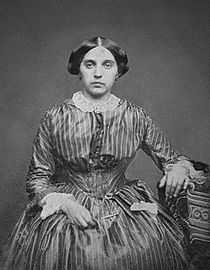Camila O'Gorman
| Camila O'Gorman | |
|---|---|
 Camila O'Gorman at age 23, 1848 | |
| Born |
1825 Buenos Aires |
| Died |
1848 (aged 23) San Andrés |
| Nationality | Argentine |
Camila O'Gorman (1825-1848) was a wealthy socialite and figure of scandal in 19th century Argentina. She was executed during the last stages of pregnancy.
Biography
Camila was born in Buenos Aires, the youngest daughter of Adolfo O'Gorman and his wife, Joaquina Ximénez Pinto (d.1852). She was the second-to-last of six children in an upper-class family of mixed Irish, French, and Spanish descent. Typical of powerful families in Argentina's post-colonial era, two of her brothers went on to pursue respectable careers. One was as an ordained a priest of the Jesuit Order, and the other as police officer and the eventual founder of the Buenos Aires Police Academy. Camila was considered a pillar of polite society, frequently dancing at formal balls at the Presidential Palace. She was also a close friend and confidante of Rosas' daughter.
In her late teens, Camila was introduced to Father Ladislao Gutiérrez, a Jesuit priest who had attended seminary with her brother. Father Gutiérrez came from a similar background; his uncle was the Provincial Governor of Tucuman. He had been assigned as the O'Gorman family's parish priest and was soon being frequently invited to her family's estate. They soon began a clandestine affair.
In 1847 Gutiérrez made a sacrilegious theft, which was punished with death penalty,[1] so he escaped with Camila and they found asylum in Corrientes Province, which was then under the control of Benjamín Virasoro, hostile to the regime of Juan Manuel de Rosas. As the scandal broke, the supporters of Rosas suggested that she had been kidnapped. Rosas' exiled political opponents, and future President Domingo Faustino Sarmiento, declared that Rosas' tyranny was responsible for the moral corruption of Argentine womanhood.
They were tracked down and arrested by an Irish priest named Fr. Michael Gannon. To the shock and horror of all following the story, Camila claimed that it had been she who had initiated the affair and insisted on their elopement, angrily denying rumors that she had been raped.
Camila O'Gorman and Fr. Gutiérrez were executed by a firing squad on 18 August 1848 in the prison town of Santos Lugares de Rosas (today San Andrés town in General San Martín, Buenos Aires province). Camila O'Gorman was 23 and was eight months pregnant with the illegitimate child of Father Ladislao Gutiérrez. Rosas accepted full responsibility for the execution, and said that nobody had made any plea for the couple.[1]
In the aftermath of their deaths, Sarmiento and his fellow Unitarios started writing about "the beautiful girl," "the doomed couple," and "the repression of love".[citation needed]
In Film
- 1910 - Camila O'Gorman, directed by Mario Gallo and starring Blanca Podestá in the title role. It was one of the first feature films made in Argentina, and is now lost.
- 1984 - Camila, directed by María Luisa Bemberg and starring Susú Pecoraro as Camila O'Gorman, Imanol Arias as Father Gutiérrez, and Héctor Alterio. It was Argentina's second nomination ever to an Academy Award (the Academy Award for Best Foreign Language Film).
Further reading
- Coghlan, Eduardo A., Los Irlandeses en Argentina: su Actuación y Descendencia (Buenos Aires, 1987), p. 420. (Spanish)
- Julianello, Maria Teresa, The Scarlet Trinity: The Doomed Struggle of Camila O'Gorman against Family, Church and State in 19th-Century Buenos Aires. (Cork: Irish Centre for Migration Studies, 2000).
- Luna, Félix (ed.), Camila O'Gorman (Buenos Aires: Planeta, 2002). (Spanish)
Bibliography
- Lascano, Marcelo (2005). Imposturas históricas e identidad nacional (in Spanish). Buenos Aires: El Ateneo. ISBN 950-02-5900-1.
References
External links
- Murray, Edmundo. "O'Gorman, Camila (1828-1848), figure of scandal"
- (spanish) History of Santos Lugares prison
|